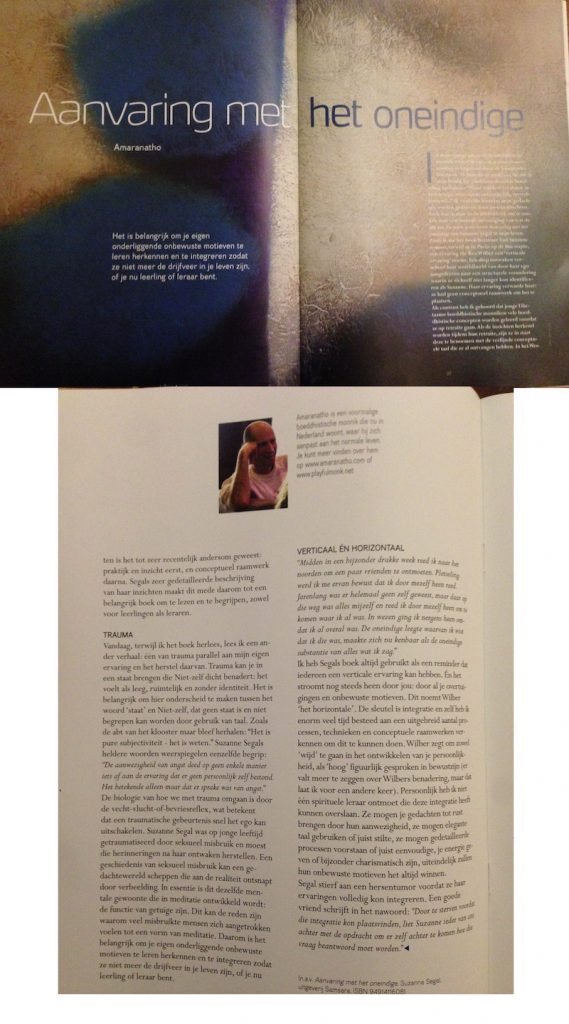On a warm summer afternoon day in England I wandered around the monastery library in the early days of my Buddhist monastic journey. I had the voice of the Abbott in my head who endlessly said the same message, “Wake up! trust in awareness, be open, receptive, welcoming…” I doubted this; my mind was driven by other forces. Still there I was again in the library looking for mental confirmation of what the Abbott was saying and then ‘Collision with the Infinite’, a book by Suzanne Segal, entered my life.
As I remember the book, Suzanne had an experience of stepping on a bus in Paris and having what Ken Wilber calls a vertical experience. A profound awakening shifted her worldview from being driven by her ego to a structural change where she could no longer identify herself as Suzanne. She was confused and dazed by the experience, lacking a conceptual framework to place her experience.
In contrast I have heard that young Tibetan Buddhist monastics are taught many Buddhist concepts and after that they go on retreat. As the insights are recognized during their retreat they are able to label them with the refined conceptual language that they’ve received already. In the West it has up to very recently been practice and insight first, and the conceptual framework second. Segal’s very detailed account of her experiences makes her book important to read and understand, both for students and teachers.

As I re-read the book today I read a different story: one of trauma which parallels my own experience and recovery. Trauma can put you into a state very close to non-self which can feel empty, spacious and lacking an identity. It is important to distinguish the word ‘state’ here from non-self, which is not a state and cannot be understood by using language. As the Abbott of the monastery kept repeating: “It is pure subjectivity – it is knowing.” Suzanne Segal’s clear words reflect a similar understanding:
“I saw that the presence of fear meant only one thing – it meant that fear was present.”
The biology of how we deal with trauma is via the flight-flight-freeze response which means trauma can shut down the ego fast. Suzanne Segal was traumatized by sexual abuse at a young age and had recovered memories from that after her awakening. A history of sexual abuse can develop a mind which escapes from reality into imagination, which is in essence the same mind a meditator creates: the witnessing mind. This may be the reason why many abused people are attracted to some form of meditation. It is very important to learn to recognize and integrate your own underlying unconscious motives so that they are not the drivers anymore, be you a student or a teacher.
“In the midst of a particularly eventful week, I was driving north to meet some friends when I suddenly became aware that I was driving through myself. For years there had been no self at all, yet here on this road everything was myself, and I was driving through me to arrive where I already was. In essence, I was going nowhere because I was everywhere already. The infinite emptiness I knew myself to be was now apparent as the infinite substance of everything I saw.”[4]
I have always used Segal’s book as reminder that anybody can have a vertical experience. And it still has to come through you: through all your beliefs and unconscious motives, which Wilber calls the horizontal. The key is integration and I have spent a vast amount of time exploring tools, processes, techniques and conceptual frameworks to do this. Wilber says to go both wide in the development of your personality, and high metaphorical speaking in awareness (there is more to say about Wilber’s approach and I will leave that for another day). Personally I have not met any spiritual teacher who has been able to bypass this. They may still your mind in their presence, they may have fancy language or silence, have highly detailed processes or simplicity, give you high energy, be charismatic and at the end of the day their unconscious motives always win.
Segal died from a brain tumor before she was able to fully integrate her experience. As Stephan Bodian, Segal’s close friend, writes in the book’s afterword “By dying before this integration had occurred, Suzanne left each of us with the koan of discovering it for ourselves.”

 image is from
image is from 


